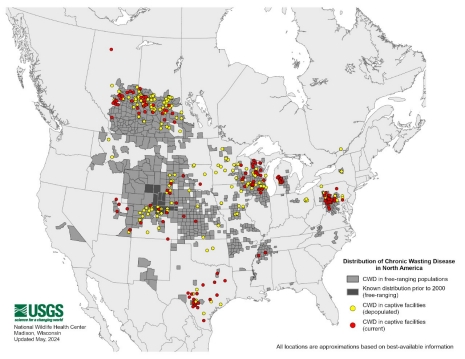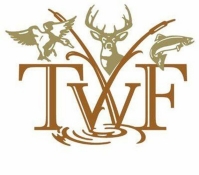
What is CWD?
Chronic wasting disease (CWD) is a progressive, fatal disease of the nervous system of cervids (members of the deer family) including white-tailed deer, mule deer, elk, and moose. It belongs to a family of diseases known as Transmissible Spongiform Encephalopathies (TSEs) or prion diseases. Although CWD shares certain features with other TSEs, like bovine spongiform encephalopathy (or mad cow disease), scrapie in sheep and goats, and Creutzfeldt -Jakob disease in humans, it is a distinct disease affecting only cervids. It causes damage to portions of the brain, creating holes in the brain cells and causing a sponge-like appearance.
CWD is transmitted both directly through animal-to-animal contact and indirectly through food and soil contaminated with bodily excretions including feces, urine, and saliva. Contaminated carcasses or high-risk carcass parts may also spread the disease indirectly through environmental contamination, which lasts for years, if not decades.
CWD is a slowly progressing disease and is harbored in an infected animal long before the animal shows signs. Signs typically are not seen until the animal is 12-18 months old and may take as long as 3 years or more. CWD attacks the brains of infected animals, causing them to become emaciated, display abnormal behavior, lose bodily functions, become weak and eventually die. Signs include excessive salivation, loss of appetite, weight loss, excessive thirst and urination, listlessness, teeth grinding, lowering of the head and drooping ears.
Currently, there is no direct evidence that CWD poses a risk to people; but, the Centers for Disease Control (CDC) recommends to have deer meat harvested in a CWD positive area tested for CWD and that meat from an animal that tests positive for CWD should not be consumed.
Please understand that CWD poses the largest threat to Tennessee’s deer and elk populations since the dawn of wildlife management more than 100 years ago.
Public Health Concerns
The Centers for Disease Control and Prevention (CDC) is the nation’s health protection agency and is the authority on disease threats to humans, including the impacts of chronic wasting disease. See the CDC website for more details on CWD Prevention.
A summary of CDC Recommendations: To date, there have been no reported cases of CWD infection in humans. However, some animal studies suggest CWD poses a risk to certain types of non-human primates. To be as safe as possible and decrease the potential risk of exposure to CWD, hunters should take the following steps when hunting in areas with CWD:
- Have your deer tested for CWD before eating it. If it tests positive, do not eat the deer.
- When field-dressing or processing a deer:
- Wear latex or rubber gloves
- Minimize how much you handle the organs, particularly the brain or spinal cord tissues.
- Do not use household knives or other kitchen utensils
- If you have your deer or elk commercially processed, consider asking that your animal be processed individually to avoid mixing meat from multiple animals.
Global Distribution of CWD
Chronic wasting disease (CWD) has been detected in 32 US states, four Canadian provinces, Norway, Finland, Sweden, and South Korea in free-ranging cervids and/or commercial captive cervid facilities.
Members of the cervid family that have tested positive for CWD in North America include white-tailed deer, mule deer, elk, and moose. Caribou, i.e., reindeer, have not been detected with CWD in North America.
For the most up to date distribution of CWD in North America see the U.S. Geological Survey (USGS) webpage.
Photo Credit: Distribution of Chronic Wasting Disease in North America, updated February, 2024. (Credit: Bryan Richards, USGS National Wildlife Health Center. Public domain.)
CWD Fact Sheets
Save, print, and study these helpful documents on CWD.
TWRA Why Shoot More Deer in Unit CWD?
University of Tennessee Extension Document on CWD
USGS Document on CWD
Additional Trustworthy Sources
Chronic Wasting Disease Alliance
National Deer Association CWD Resource Center and 10 Reasons You Don't Want CWD
Cornell Wildlife Health Lab – Surveillance Optimization Project for Chronic Wasting Disease (SOP4CWD)
Our Friends at TN Wildlife Federation Understand the Impact Of CWD
The state’s largest sportsman’s group is the Tennessee Wildlife Federation. This is an organization that TWRA has worked with on numerous projects through many years. Like our agency, the TWF is extremely concerned about Chronic Wasting Disease. Please visit TWF’s page about CWD to learn more from the sportsman’s point of view concerning the perils of this deadly disease.





